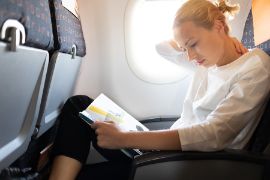Flying is a common way to travel, and most people may see it as an opportunity to relax and rest during the trip. However, it is important to remain relatively active while on a plane.
 Sitting for extended periods during long flights, or taking multiple flights within a short space of time, increases the risk of experiencing muscle and joint pain, cramps or venous thromboembolism (VTE) or deep vein thrombosis (DVT).
Sitting for extended periods during long flights, or taking multiple flights within a short space of time, increases the risk of experiencing muscle and joint pain, cramps or venous thromboembolism (VTE) or deep vein thrombosis (DVT).
VTE refers to the formation of a blood clot in a deep vein due to poor circulation, while DVT is described as poor blood circulation that leads to the formation of blood clots in the legs; the clots subsequently obstruct blood flow to the heart.
There are a number of easy ways to stay active during a flight, and the following exercises help reduce the occurrence of flight-related health problems:
- Performing knee lifts while sitting or standing
- Pumping the feet while sitting in the seat - or draw the alphabet with your feet
- Squeezing the buttock muscles while sitting
- Performing neck rolls to prevent neck pain
- Rolling the shoulders and gently twisting the torso left and right
- Stretching the upper body by reaching upwards and side to side
- Frequently walking up and down the aisle of the plane, if possible
- Performing calf muscle exercises such as lifting both heels while standing
- Alternating between lifting the toes and the heels to improve blood flow in calf veins
- Wearing travel compression stockings
For individuals who are at risk for or have a history of VTE or DVT, physiotherapy is recommended to help regain mobility immediately after being diagnosed with this issue, and help develop long term strategies for maintaining optimal blood flow through mobility and activity. The role of a physiotherapist in such cases is to educate you regarding the signs and symptoms of DVT or VTE, to introduce preventative activities, to encourage proper hydration, and to use mechanical compression when it is necessary. Mechanical compression involves the use of equipment such as an intermittent pneumatic compression device or graded compression stockings (GCS). Intermittent pneumatic compression devices are air-filled cuffs placed around the legs that repeatedly inflate and deflate to increase blood flow in the veins and prevent blood clots. Graded compression stockings (GCS) exert a large degree of compression at the ankle, and the pressure it places on the lower extremities gradually decreases as the stocking extends upward.
When struggling with joint stiffness, back or neck pain after travelling, visiting a physiotherapist can help. They can use hands-on techniques to ease joint and muscle tension and start you on a regime of therapeutic exercise to get you feeling your best again. If you know you have an upcoming flight, a physiotherapist can assist in getting you ready with some preventative work, particularly if you believe you are at risk for VTE or DVT, or you have a history of these conditions. In addition to providing education regarding the warning signs of serious complications and dehydration, a physiotherapist can demonstrate exercises that improve blood flow while flying, and may also recommend the use of GCS that provide between 15-30 mm Hg of compression to the legs.
Flying is an essential means of transportation for many people, and the risk of experiencing health problems such as stiff joints, back pain, VTE, or DVT can be reduced by engaging in brief physical activity during a flight. A physiotherapist can assess your current state, get a detailed history of how you live, work, and play plus devise a treatment plan to match your individual needs.
References
1. Sokol HN. Venous thrombosis related to air travel. JAMA. 2013;309(13):1347.
2. Hillegass E, Puthoff M, Frese EM, et al. Role of physical therapists in the management of individuals at risk for or diagnosed with venous thromboembolism: Evidence-based clinical practice guideline. Phys Ther. 2016;96(2):143-66.
3. Sugerman HJ, Eklöf BG, Toff WD, Burke AE, Livingston EH. JAMA patient page: Air travel-related deep vein thrombosis and pulmonary embolism. JAMA. 2012;308(23):2531.
4. Lim CS, Davies AH. Graduated compression stockings. CMAJ. 2014;186(10):E391-8.
5. Bates SM, Jaeschke R, et al. Diagnosis of DVT: Antithrombotic therapy and prevention of thrombosis, 9th ed: American College of Chest Physicians Evidence-Based Clinical Practice Guidelines. Chest. 2012 Feb;141(2 Suppl):e351S-e418S.
